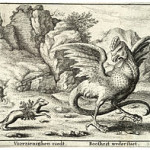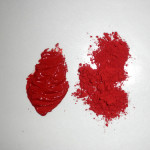Many of the quirkiest stories I have told have been right here in this blog during my Lessons from the Low Countries series. Remember the one about the red haired man and the basilisk? If you recall, a basilisk is the legendary reptile, hatched by a serpent (or toad, depending on the source) from a rooster’s egg, and is so revolting, if it gazes at you, it could be curtains, for you, not the basilisk.

Of the many sources of this story, this one came from the writings of Theophilus. “To make Spanish Gold you must use copper, basilisk powder, human blood, and vinegar. The human blood must be the dried ground blood from a red haired man.” One of my faithful readers, Sander, who boasts a head of red hair, has volunteered for this project.
Another strange but true legend is about the creation of cinnabar or its synthetic counterpart, vermilion. As a clarification, natural cinnabar is one of earth’s splendid minerals and is found many places in the world including here in the Northwest. Vermilion is made by alchemy, but both are made from a blending of sulfur and mercury, the former using very hot temperatures. Pliny the Elder related that this pigment was the result of a monumental struggle between an elephant (the sulfur) and a dragon (the mercury).

I will await word from Sander on this. In the meantime, what quirky tales do you have about pigments or other art related techniques?

Margret, between my email changes and your web change I lost contact for awhile but now I see that I have been summoned up like a mythical creature. My Samsonite ginger red hair has long ago gone white wizard on me.
Your current sample appears to be a very clean relatively cool cinnabar as far as one could tell across monitors. Do you have a warmer one for comparison or a series that would include mercury sulphide as well as a comparable Cadmium red? A favorite? One of the beautiful things about named powdered pigments is that you can be reasonably sure of the product’s genuineness. I will never know for sure if some tubed vermillions may also be enhanced by some cadmium pigment. It’s really a miracle that some like George O’Hanlon and Kremer make these precious things available.